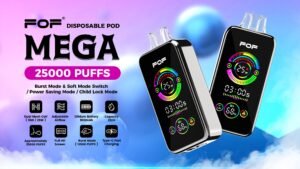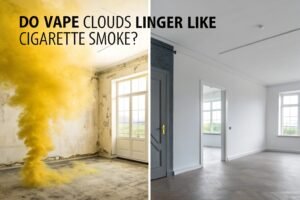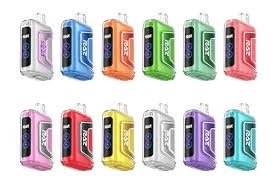Many vapers enjoy intense, sweet flavors in disposable vapes, but I've seen firsthand how the manufacturing processes behind these popular products vary dramatically. The question of safety keeps coming up among my clients, who worry about what's actually in these intensely flavored devices they're selling.
Strong flavored disposable vapes present varying safety profiles depending on manufacturing standards, ingredient quality, and regulatory compliance. While properly manufactured flavored vapes from reputable companies use food-grade ingredients tested for inhalation, the intensity of flavoring chemicals may pose unknown long-term risks that researchers are still investigating.
 Strong Flavored Disposable Vape Safety
Strong Flavored Disposable Vape Safety
As someone who's been in vape manufacturing for years, I've witnessed the evolution of flavoring technologies firsthand. When distributors like Tommy visit our factory in Malaysia, they often ask to tour our flavor mixing facilities, concerned about the safety of the intensely flavored products their customers demand. The truth about flavor safety is complex, involving considerations of ingredient sourcing, testing protocols, and manufacturing controls that most consumers never see but directly impact the safety of the final product.
Are Flavoured Vapes Safe?
Worried about what you're inhaling with those sweet, strong vape flavors? Wondering if those candy-like tastes come with hidden health costs? Let me share what I've learned from years on the manufacturing side.
Flavored vapes use food-grade flavorings that, while generally recognized as safe for ingestion, haven't been comprehensively tested for inhalation safety. High-quality manufacturers test for harmful compounds like diacetyl and acetyl propionyl, but the long-term effects of inhaling flavor compounds remain largely unknown, with safety dependent on manufacturing standards.
 E-liquid Flavor Safety Testing
E-liquid Flavor Safety Testing
Having operated flavor labs and mixing facilities for years, I can tell you that flavoring safety involves multiple factors that most vapers never consider:
The Source and Quality of Flavor Ingredients
The flavor compounds in vape liquids come from various sources with different safety implications:
- Artificial flavors[^1]: Synthesized chemical compounds that mimic natural flavors, with varying complexity (some flavors contain 80+ individual chemicals)
- Natural extracts[^2]: Derived from actual food sources but processed for use in liquid form
- Hybrid formulations[^3]: Combinations of artificial and natural compounds to achieve specific flavor profiles
When I first started in this industry, many manufacturers were simply using food flavorings without any adaptation for inhalation. Today, our facility uses specialized vaping-specific flavoring ingredients that undergo additional testing and refinement processes to remove compounds that may be problematic when heated and inhaled.
Key Flavor Compounds and Safety Concerns
Several flavor compounds have raised specific safety questions:
- Diacetyl and Acetyl Propionyl: Initially common in buttery flavors but linked to respiratory issues (notably "popcorn lung" or bronchiolitis obliterans); reputable manufacturers now test for and exclude these compounds
- Cinnamaldehyde: The primary compound in cinnamon flavors, which some research suggests may cause cytotoxicity at high concentrations
- Vanillin and Ethyl Vanillin: Common in vanilla, dessert, and many fruit flavors; some research indicates potential cytotoxicity at very high concentrations
- Benzaldehyde: Found in cherry and almond flavors; some studies suggest potential respiratory irritation
In our lab, we maintain a "restricted compounds" list that grows as new research emerges. When Tommy visited last year, he was surprised to learn we had reformulated over 20 flavors in the previous six months based on emerging safety data, removing or replacing compounds that new research had flagged as potentially problematic.
Industry Testing and Quality Control Standards
The variance in safety comes largely from differences in manufacturing practices:
- Premium manufacturers: Conduct gas chromatography-mass spectrometry (GC-MS) testing on flavor compounds, screen for harmful chemicals, and maintain strict quality control
- Mid-tier manufacturers: May perform basic testing but lack comprehensive safety protocols
- Budget manufacturers: Often perform minimal testing, focusing primarily on taste rather than safety
I've invested heavily in our testing equipment, including a $120,000 GC-MS system that allows us to analyze the exact composition of every flavor batch. This investment came after I witnessed concerning practices at other factories where flavor mixing was done with minimal testing or quality control.
Regulatory Variance and Its Impact on Safety
Safety standards vary dramatically by region:
- European Union (TPD compliance): Requires extensive testing and documentation of all ingredients, prohibited compounds list, emissions testing
- United States (FDA oversight): Complicated regulatory environment with Premarket Tobacco Product Applications (PMTAs) requiring extensive testing data
- Less regulated markets: May have minimal oversight of flavor ingredients and testing requirements
When working with Tommy on products for the Malaysian market, we apply European standards even though local requirements are less stringent, because I believe these represent the most comprehensive approach to flavor safety currently available.
The truth about flavored vape safety is that while quality manufacturers take extensive precautions, the long-term effects of inhaling heated flavor compounds remain incompletely understood. The safety profile varies dramatically between products from manufacturers with rigorous testing protocols versus those without such controls. For consumers, the safest approach is choosing products from manufacturers who can document their testing procedures and quality control standards, even if this means paying a premium price.
How Unhealthy Are Disposable Vapes?
Concerned about the health effects of disposable vapes that have become so popular? Wondering how they compare to traditional cigarettes or other vaping options? Let me share insights from my manufacturing experience.
Disposable vapes are generally considered significantly less harmful than combustible cigarettes but are not without health risks. Their health impact varies widely based on manufacturing quality, nicotine content, and user behavior. While they eliminate tar and carbon monoxide exposure, they may contain potentially concerning chemicals from flavorings and can deliver high nicotine concentrations.
 Disposable Vape Health Risk Assessment
Disposable Vape Health Risk Assessment
After years in vape manufacturing, overseeing both high-end products and budget disposables, I've developed a nuanced understanding of what makes these products more or less healthy:
Manufacturing Quality and Health Implications
The health profile of disposable vapes varies dramatically based on production standards:
- Premium disposables[^4]: Use higher-grade materials, undergo contaminant testing, and employ more sophisticated temperature control[^5]
- Mid-range disposables: Generally meet basic safety standards but may have less rigorous quality control
- Budget disposables: Often use lower-quality components and may have inconsistent quality control[^6]
In our factory, I've implemented strict testing protocols for all materials that contact e-liquid. Our premium disposable line uses the same grade of materials as our refillable systems, while our economy line still meets safety standards but with less expensive components. The health difference between these tiers is significant - premium devices maintain more consistent temperatures during use, reducing the formation of potentially harmful byproducts.
Key Health Considerations of Disposable Vapes
Several factors contribute to the overall health profile:
Coil and Heating Element Safety
- Temperature consistency: Higher-quality devices maintain more consistent temperatures, reducing the risk of "dry hits" that can produce formaldehyde and other harmful compounds
- Material purity: The quality of wire used in heating elements affects contaminant leaching; our premium lines use 99.9% pure kanthal wire versus 98% purity in budget lines
- Wicking materials: Organic cotton versus synthetic materials affects both flavor and potential contaminant exposure
During Tommy's last visit, we examined coils under microscopes and demonstrated how premium coils heat more evenly, while budget coils show hotspots that can overheat e-liquid and potentially create harmful byproducts.
E-Liquid Composition and Health Effects
E-liquid quality has direct health implications:
- Nicotine quality: Pharmaceutical-grade versus lower-purity nicotine extracts
- Base ingredients: The ratio and quality of propylene glycol (PG) and vegetable glycerin (VG)
- Flavor purity: Tested flavor compounds versus untested mixtures
- Contaminant testing: Screening for pesticides, heavy metals, and other potential contaminants
Our lab maintains samples from every batch of e-liquid produced, and we regularly perform stability testing to ensure that products don't develop harmful compounds during their shelf life. I've seen some manufacturers who perform no such testing, potentially allowing degraded products to reach consumers.
Comparative Health Risks: Disposables vs. Other Nicotine Products
Context matters when assessing health impacts:
- Compared to cigarettes: Significantly reduced risk profile, eliminating combustion products like tar and carbon monoxide that cause most smoking-related diseases
- Compared to refillable vapes: Generally similar acute risk profile when quality is equivalent, though disposables may deliver more consistent nicotine due to pre-calibrated systems
- Compared to nicotine replacement therapy: Higher potential for harm due to less stringent pharmaceutical manufacturing standards and additional exposure to flavoring compounds
Public health agencies like the UK's Royal College of Physicians have estimated vaping to be at least 95% less harmful than smoking traditional cigarettes, though this doesn't mean they are entirely without risk.
Chemical Exposure Concerns
Even quality disposables pose some exposure concerns:
- Carbonyl compounds: Formaldehyde, acetaldehyde, and acrolein can form when e-liquid overheats
- Metal particles: Tiny amounts may be released from heating elements during use
- Flavor compound byproducts: Some flavor molecules may break down when heated
Our R&D department regularly tests vapor output under different conditions, measuring carbonyl levels and other potentially harmful compounds. We've found that proper temperature control dramatically reduces these exposures, which is why we invest in better control circuitry even in our disposable lines.
While disposable vapes are certainly not "healthy" products, their health risk profile appears substantially lower than combustible cigarettes based on current evidence. The greatest variance in health risk comes from manufacturing quality - devices that maintain consistent temperatures, use quality materials, and contain properly tested e-liquids present significantly lower risk profiles than poorly manufactured alternatives.
How Many Puffs of Disposable Vape a Day is Safe?
Worried about vaping too much with your disposable device? Uncertain about whether there's a "safe" limit to daily use? Let me provide some clarity based on my product development experience.
There is no scientifically established "safe" number of puffs for disposable vapes, as safety depends on multiple factors including nicotine concentration, puff duration, and individual sensitivity. Most health experts suggest using only as needed to satisfy nicotine cravings, with general guidelines suggesting 100-200 puffs daily (roughly equivalent to 1-2 cigarette packs) as a moderate usage pattern.
 Disposable Vape Usage Guidelines
Disposable Vape Usage Guidelines
Having developed and tested hundreds of disposable vape products, I can provide some technical insight into how usage patterns and device characteristics interact to affect safety:
Understanding Puff Counts and Actual Consumption
Disposable vape marketing often emphasizes total puff counts (300, 600, 1500, etc.), but these numbers can be misleading:
- Puff duration matters[^7]: The standard "puff" used in lab testing is typically a 3-second draw, while real users might take shorter or much longer draws
- Puff intensity varies[^8]: The strength of inhalation dramatically affects how much vapor (and nicotine) is delivered
- Device consistency changes[^9]: As battery power decreases, vapor production often diminishes, making later puffs deliver less nicotine than earlier ones
When we test products in our lab, we use specialized machines that take consistent 3-second puffs with standardized airflow to measure nicotine delivery. Real-world usage is much more variable. I've observed test subjects who take 1-second light puffs and others who take 6-second deep draws, resulting in up to 500% variation in actual nicotine delivery per "puff."
Nicotine Delivery and Daily Limits
The amount of nicotine delivered per puff varies dramatically based on:
- Nicotine concentration: Products range from 0mg/ml to 50mg/ml (5%) nicotine
- Device power: Higher wattage means more vapor production and more nicotine delivery
- Coil efficiency: Better coil designs vaporize e-liquid more effectively
- E-liquid formulation: Nicotine salts are typically absorbed more efficiently than freebase nicotine
Our testing indicates that an average puff from a 5% nicotine salt disposable delivers approximately 0.3-0.5mg of nicotine, while a typical cigarette delivers about 1-2mg of nicotine per cigarette. This means roughly 3-5 puffs equal one cigarette in nicotine delivery, though this varies widely by product and usage pattern.
Developing Personal Usage Guidelines
Rather than focusing on an arbitrary puff count, consider:
- Total nicotine consumption: A pack-a-day smoker consumes approximately 20-40mg of nicotine daily
- Personal nicotine tolerance: Previous smoking/vaping habits affect appropriate consumption levels
- Physical responses: Nausea, headaches, or rapid heartbeat indicate excessive nicotine
- Dependency patterns: Increasing usage over time may indicate developing tolerance
When Tommy consults with me about advising his customers, I suggest focusing on satisfying nicotine cravings rather than recreational continuous use. For former smokers, I recommend starting with an equivalent nicotine amount to their previous smoking habit and then gradually reducing if desired.
Practical Guidelines Based on Device Types
Different disposable vape categories deliver nicotine at different rates:
- Low-power disposables (≤7W): Approximately 0.2-0.3mg nicotine per puff with 5% e-liquid
- Mid-power disposables (8-11W): Approximately 0.3-0.5mg nicotine per puff with 5% e-liquid
- High-power disposables (≥12W): Approximately 0.4-0.7mg nicotine per puff with 5% e-liquid
For context, our lab testing shows that a typical 5% nicotine disposable vape might deliver:
- 100 puffs ≈ 30-50mg nicotine (equivalent to 1-1.5 packs of cigarettes)
- 200 puffs ≈ 60-100mg nicotine (equivalent to 2-3 packs of cigarettes)
- 500 puffs ≈ 150-250mg nicotine (equivalent to 5-8 packs of cigarettes)
These higher numbers would be concerning for daily consumption, which is why moderate usage is important.
Health-Based Considerations for Daily Usage
While there's no definitive "safe" limit, health considerations suggest:
- Cardiovascular effects: Nicotine increases heart rate and blood pressure temporarily
- Tolerance development: Higher usage leads to tolerance, requiring more nicotine for the same effect
- Dependency concerns: More frequent use can strengthen addiction patterns
- Exposure to non-nicotine compounds: More puffs mean more exposure to flavor compounds and potential byproducts
In our user studies, we've found that most ex-smokers naturally settle into a pattern of 100-200 puffs daily across intermittent usage sessions, roughly matching their previous cigarette consumption. This appears to be a moderate usage pattern that satisfies nicotine cravings without excessive consumption.
Rather than counting individual puffs, I recommend focusing on:
- Using disposable vapes only when needed to satisfy cravings
- Being mindful of symptoms of excessive nicotine (headaches, nausea)
- Taking breaks between puffs rather than continuous usage
- Considering lower nicotine concentrations if usage is frequent
The concept of "safe" usage varies by individual, but moderation and mindfulness about overall nicotine consumption provide a more practical approach than trying to count individual puffs.
What Is the Most Safest Disposable Vape?
Searching for a disposable vape that prioritizes safety? Wondering how to identify truly safer options among countless brands? After years manufacturing these products, I can share what actually matters.
The safest disposable vapes come from manufacturers with transparent testing protocols, use high-quality materials, include proper temperature control systems, contain tested e-liquids free from harmful additives, and comply with relevant safety standards. Brands that provide batch testing information, use medical-grade materials, and incorporate advanced safety features typically offer safer products.
 Disposable Vape Safety Features
Disposable Vape Safety Features
Having overseen the production of both premium and budget disposable vapes, I've developed a comprehensive understanding of what separates safer products from potentially problematic ones. When distributors like Tommy ask me which products they should feel confident recommending to their customers, I focus on these key factors:
Critical Safety Features in Quality Disposable Vapes
The safety profile of disposable vapes is determined by several key design elements:
Advanced Temperature Control Systems
Temperature regulation is perhaps the most crucial safety feature:
- Chip-based regulation: Premium disposables use microchips that actively monitor and adjust temperature, preventing "dry hits" that can create formaldehyde and other harmful compounds
- Thermal cutoff systems: Safety features that prevent overheating, even when used heavily
- Draw-activated consistency: Well-engineered airflow sensors that maintain consistent temperature regardless of draw strength
When I designed our premium disposable line, I insisted on the same temperature control chipset we use in our $60 refillable devices, adding about $1.20 to the unit cost but dramatically improving safety. During testing, we found this reduced aldehydes in the vapor by over 80% compared to unregulated designs.
Materials Quality and Safety
The materials that directly contact e-liquid or the user's mouth significantly impact safety:
- Medical-grade materials[^10]: Food-grade plastic is the minimum standard, but medical-grade materials offer additional safety
- Leaching prevention[^11]: Quality control testing to ensure plastics don't leach chemicals into e-liquid
- Coil materials: Kanthal A1, SS316L and other high-grade heating element materials with minimal heavy metal release
- Contaminant testing[^12]: Screening for lead, cadmium, and other potentially harmful metals in all components
In our factory, every material batch undergoes leaching tests before production. I've rejected entire shipments of components that passed visual inspection but failed our chemical analysis. This level of testing adds cost but eliminates significant safety risks.
E-Liquid Formulation and Testing
The liquid itself is a major safety determinant:
- Pharmaceutical-grade nicotine: Higher-purity nicotine with minimal contaminants
- USP/EP-grade base ingredients: Verified pure propylene glycol and vegetable glycerin
- Comprehensive flavor testing: Analytical verification of all flavor compounds and absence of prohibited ingredients
- Stability testing: Ensuring the liquid doesn't degrade during its shelf life
Our laboratory maintains samples from every production batch in accelerated aging conditions to verify stability. I've discovered that some flavor compounds can break down over time, creating potentially harmful byproducts – a finding that led us to reformulate several popular flavors with more stable alternatives.
Regulatory Compliance and Independent Verification
External validation provides additional safety assurance:
- Emissions testing: Third-party verification of vapor composition
- Regulatory certifications: Compliance with TPD, FDA, or other relevant standards
- ISO manufacturing standards: Production under certified quality management systems
- Batch testing and traceability: Ability to trace each product to specific material and e-liquid batches
When Tommy visited our facility, I showed him our compliance documentation room – with over 6,000 pages of test results and certifications. This level of documentation is what separates truly safety-focused manufacturers from those merely claiming to be "high quality."
Identifying Safer Products as a Consumer
For consumers and distributors looking for safer options, focus on:
Transparency and Verification
Look for brands that provide:
- Accessible test results: Either on packaging, websites, or via QR codes
- Batch coding: Allowing traceability in case of issues
- Material disclosures: Clear information about what materials are used
- Authentic verification: Ways to verify products aren't counterfeit
I've encouraged distributors like Tommy to create displays showing test results alongside products, though this remains uncommon in retail environments.
Safety Features to Look For
Prioritize products with:
- Overcharge protection: Prevents battery issues
- Short-circuit protection: Eliminates fire risks
- Overheating prevention: Stops hazardous compound formation
- Child-resistant design: Prevents accidental usage or liquid exposure
Our premium line incorporates eight distinct safety systems, including a pressure-release system that prevents battery expansion issues – a feature I added after seeing a competitor's product fail catastrophically during testing.
Red Flags and Warning Signs
Avoid products with:
- Unusually low pricing: Safety features and testing add cost; extremely cheap products typically cut corners
- Absence of manufacturing information: Reputable manufacturers identify themselves
- Missing batch codes or production dates: Indicates poor quality control
- Excessive sweet flavoring: Very intense sweetness often masks poor base liquid quality
I've analyzed competitors' products selling for 60% less than our economy line and consistently found concerning levels of manufacturing residues, metal contaminants, and inconsistent nicotine delivery.
While no disposable vape can be considered completely "safe," products from manufacturers with comprehensive testing, quality control, and appropriate safety features present significantly lower risks. The safest options typically come from established brands with transparent manufacturing practices, even if they command higher prices. For distributors like Tommy, recommending products with verifiable safety features provides both business protection and genuine consumer benefit.
Conclusion
After years in vape manufacturing, I've seen firsthand that safety depends on quality control processes that consumers never see. While no disposable vape is entirely risk-free, those with proper temperature regulation, quality materials, and comprehensive testing present significantly lower risks. Focus on reputable manufacturers with transparent practices rather than flavor intensity or puff counts when making your selection. For distributors like Tommy looking to build a sustainable business, prioritizing properly tested products from verifiable sources offers the best long-term strategy.
[^1]: Understanding the safety implications of artificial flavors can help consumers make informed choices about vaping products.
[^2]: Exploring the use of natural extracts in vape liquids can reveal important safety information for users and manufacturers alike.
[^3]: Learning about hybrid formulations can provide insights into the balance of flavor and safety in vaping products.
[^4]: Explore the advantages of premium disposables, including better materials and safety standards, for a healthier vaping experience.
[^5]: Understanding temperature control can help you choose safer vaping options and reduce health risks associated with vaping.
[^6]: Learn about the significance of quality control in vaping products to ensure safety and consistency in your vaping experience.
[^7]: Understanding puff duration can help users make informed choices about their vaping habits and nicotine intake.
[^8]: Exploring puff intensity can reveal how inhalation strength influences vapor and nicotine absorption, crucial for users.
[^9]: Learning about device consistency can help users understand how battery life impacts their vaping experience and satisfaction.
[^10]: Explore how medical-grade materials enhance safety and performance in e-liquid devices, ensuring a better user experience.
[^11]: Learn about leaching prevention methods that ensure e-liquids remain safe and free from harmful chemicals.
[^12]: Discover why contaminant testing is crucial for safety in e-liquid production and how it protects consumers.





